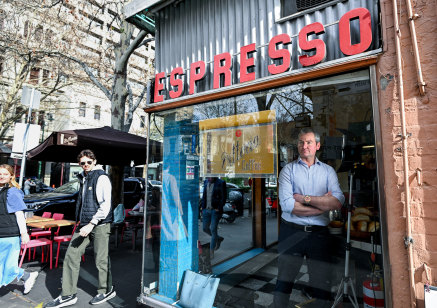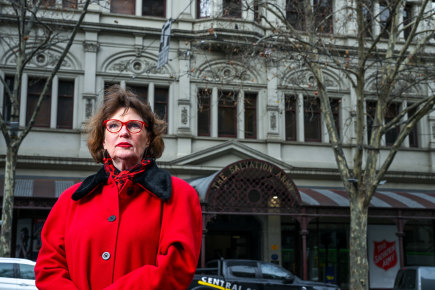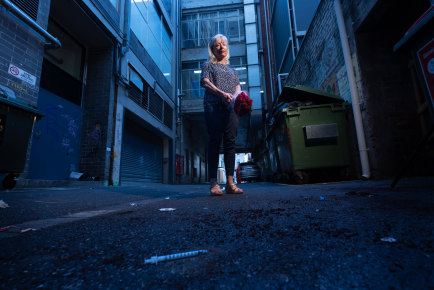Save articles for later
Add articles to your saved list and come back to them any time.
“The thing about an injecting room,” says Pellegrini’s co-owner David Malaspina, “is that it’s going to bring all the drug dealers here. It’s going to create a honeypot.”
Malaspina’s iconic Melbourne restaurant, bustling when The Age visits at lunchtime on Thursday, sits directly opposite the Salvation Army’s community hub at the top end of Bourke Street.
Pellegrini’s co-owner David Malaspina at his restaurant, opposite the Salvation Army building on Bourke Street.Credit: Joe Armao
Doors away are Guy Grossi’s high-end restaurants, including the legendary Florentino, and 200 metres up the road is Parliament House.
But metres back from this bustling street, the facade slips. In the laneways beside and behind the Salvation Army building, syringes litter the ground and people are slouched on the ground or sleeping rough in doorways.
Melbourne is Victoria’s heroin capital and, in turn, Victoria is Australia’s heroin capital.
According to the Australian Criminal Intelligence Commission, which tests wastewater in capital and regional cities across the country, Victoria’s heroin consumption accounted for 46 per cent of the nation’s consumption in 2021-22. Most of this was in inner Melbourne.
The Salvation Army building is one of several buildings under active consideration to house Victoria’s long-awaited second medically supervised injecting room.
The search for a preferred location has dragged for years, since Premier Daniel Andrews announced in 2020 the government intended to open a second facility to reduce the harm caused by street drug use. Since then, dozens of people have died from heroin overdoses in the CBD.
Prior locations floated – and then abandoned – included Drill Hall, opposite the Queen Victoria Market, and the former Yooralla building near Flinders Street.
Department of Health secretary Euan Wallace last month told a parliamentary hearing his bureaucrats had “scanned the CBD looking at all opportunities for potential second injecting sites”.
But when news broke this week that the government was in talks about an injecting room within the Salvation Army hub, a familiar response followed. Just as with the other sites, the Bourke Street proposal attracted swift and vocal objections from opponents concerned about crime and anti-social behaviour, and expressions of concern from Melbourne’s lord mayor Sally Capp.
Capp, who leads a council that in 2021 narrowly voted to support a CBD injecting room, has opposed each location proposed by the government.
On Wednesday, she told 3AW host Neil Mitchell: “When it was first announced two years ago now at Drill Hall, near Queen Victoria Market, all of the same issues that we identified then, in terms of impacts on traders and local residents, I think, are multiplied in a position such as Bourke Street.”
It’s a position echoed by Malaspina, who says he supports the concept of an injecting room – but believes it should be somewhere else.
“We say this is one of the best parts of the city,” he says. “We’ve got beautiful Parliament House up the road, tour groups and theatregoers; we get school kids to look at Parliament House … You don’t really want to expose all those people to it, it’s not a good mix.”
Judy Ryan rejects the so-called “honeypot” argument. Ryan has been one of the most outspoken advocates of the Richmond supervised injecting room, having campaigned for its existence for two years before it opened in 2018.
Judy Ryan says the time for talk has passed.Credit: Eddie Jim
“The honeypot’s there,” she says bluntly. “It’s already there, as it was in Richmond. It’s been there for years.”
Ryan has been a relentless campaigner for supervised injecting facilities since 2016, when 34 people died from heroin overdoses in Richmond alone. One man who nearly became one of those statistics collapsed at Ryan’s back gate. She stayed with him until ambulance officers arrived and revived him. As she looked at him struggling to breathe, she thought: “Somebody loves you.”
“These aren’t just statistics, they’re people’s loved ones,” Ryan says. “And they are loved.”
Katrina Korver lost her beloved 38-year-old son Danial to an overdose in Rainbow Alley last year. She believes the existence of a CBD injecting facility could have saved his life.
Korver and her husband John stuck a laminated photo of their son in the laneway near the spot where Danial died, accompanied by a note reading: “Please use safe injecting rooms or always make sure someone is with you when injecting, it’s not worth the risk.”
Katrina Korver believes her son Danial would be alive if a safe-injecting room had opened in the CBD.Credit: Jason South
They visited the alley on the first anniversary of his death, and were relieved to see four men shooting up heroin next to where their son died. Why? “They were there together, looking after each other.”
The most recent data from the Coroners Court of Victoria reveals that in the two years to June 2022, 29 people died from heroin overdoses in the city centre – the highest number of any local government area.
Kathryn Wright is the national general manager of Alcohol and Other Drugs at the Salvation Army. Wright confirms the Bourke Street site – which offers food, support and information to 500 people a day – is being considered for a second supervised injecting room. From an outreach perspective, she says, supervised injecting facilities allow vulnerable people to access support services they might otherwise be unable to reach.
“Often it’s really difficult for people to access services that they need, and for workers it’s really difficult to engage people,” she says.
“How do you reach someone without a mobile phone? Who’s unable to remember appointments? There’s a whole range of hurdles. So, in providing a safe injection facility where other services are available to wrap around people, you’re not only providing a safe facility, which we know does save lives, but you also provide the pathways into other services for longer-term outcomes.”
Wright stresses that if the second injecting room is to be successful, it will need such “wrap-around” services, including allied health and counselling services, to be co-located with the injecting facility.
“It is really critical that we get big bang for our buck when we do a safe injecting service,” she says.
“Because we provide [the service], which is a worthy intervention on its own, but we also have the opportunity to do a whole lot more with people that would otherwise be very hard to achieve.”
Victoria’s first medically supervised injecting room, in North Richmond, became a permanent fixture in May.
The facility was credited in February with saving an estimated 63 lives and safely managing more than 6300 overdoses since it opened as a trial almost five years ago, but its location next to a primary school has been bitterly opposed by some residents and the state opposition.
The Andrews government committed in 2020 to opening a second injecting room in Melbourne’s CBD, on the expert advice of Professor Margaret Hamilton, an executive member of the Australian National Council on Drugs.
But the question of where that facility should be located has created headaches for government and harm reduction advocates, and infuriated those who fear having an injecting facility near their home or business.
In 2020, the Department of Health and Human Services identified Drill Hall on Victoria Street, opposite the Queen Victoria Market, as its preferred site.
The location was opposed by the City of Melbourne, lord mayor Sally Capp, Queen Victoria Market traders and others, and the government abandoned that plan in early 2021.
In May of that year, the government bought the former Yooralla building at 244-248 Flinders Street, between Elizabeth and Swanston streets, identifying it as its new preferred site.
Again, Capp raised concerns about the location, including its proximity to tourist destinations, vulnerable residents and local traders, vowing: “Any facility in the City of Melbourne can’t cost livelihoods.”
The search for a new site has been conducted at arm’s length from government, which commissioned former police commissioner Ken Lay to report on preferred locations. His report, begun in 2020, was handed to Mental Health Minister Gabrielle Williams at the end of May. Her office said she was considering the report.
Opposition leader John Pesutto said the Salvation Army hub wasn’t the right location, and called on the government to publicly release the Lay report.
“[It] would bring the Salvation Army into a place that would jeopardise the great work that it does, providing services for our most disadvantaged Victorians, people who need our help,” he said. “Can anyone realistically imagine this is the right place to host a second injecting room?”
An insider, who was not authorised to speak publicly, said a large proportion of people who drop into the Salvation Army hub are already intravenous drug users. A second said: “We call it an unsupervised injecting room. It’s not uncommon to find needles.”
Chris Lamb is a member of Keep Our City Alive, a group lobbying for an injecting room in the CBD. He says the time has come for a facility, and says the majority of people would back it.
“It’s not a crippling issue for most people who live in the city,” he says. “There’s people who are stoked up by a fear campaign, but it’s a very small minority.”
An independent review of the Richmond facility by John Ryan, which the government released in part in February, described injecting room clients as being people with complex needs who live on the margins of society.
“Many of the [medically supervised injecting room’s] 6191 registered clients have experienced high levels of psychological distress, the result of other life stressors such as housing uncertainty, unemployment, food instability, and high rates of chronic and complex health issues,” Ryan wrote.
“Registered users report a health status that is poorer than 95 per cent of the general population; they are also 12 times more likely to have moderate-to-severe depressive symptoms, and have often experienced high levels of trauma through exposure to incidents of assault, sudden violent death and childhood sexual abuse.”
The challenge for government is balancing its policy of reducing harm for people with complex problems, with the complex politics of harm reduction. Advocates say it is a task the government must achieve.
“It’s been a long time,” says Korver.“And in the meantime, we’re losing one person a month in the Melbourne CBD.”
Most Viewed in National
From our partners
Source: Read Full Article



